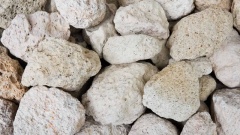Difference between revisions of "Pumice"
m |
m |
||
| Line 2: | Line 2: | ||
| image = Pumice.jpg | | image = Pumice.jpg | ||
| origin = - | | origin = - | ||
| − | | stowage factor = | + | | stowage factor = 1,90 to 3,25 m<sup>3</sup>/t |
| − | | humidity and moisture = | + | | humidity and moisture = - |
| − | | ventilation = | + | | ventilation = No special requirements |
| − | | risk factors = | + | | risk factors = See text |
}} | }} | ||
| + | ==Description== | ||
| + | Pumice is a textural term for a volcanic rock that is a solidified frothy lava typically created when super-heated, highly pressurized rock is violently ejected from a volcano. It can be formed when lava and water are mixed. This unusual formation is due to the simultaneous actions of rapid cooling and rapid depressurization. The depressurization creates bubbles by lowering the solubility of gases (including water and CO2) dissolved in the lava, causing the gases to rapidly exsolve (like the bubbles of CO<sub>2</sub> that appear when a carbonated drink is opened). The simultaneous cooling and depressurization freezes the bubbles in the matrix.<br><br> | ||
| + | Pumice is composed of highly microvesicular glass pyroclastic with very thin, translucent bubble walls of extrusive igneous rock. It is commonly, but not exclusively of silicic or felsic to intermediate in composition (e.g., rhyolitic, dacitic, andesite, pantellerite, phonolite, trachyte), but basaltic and other compositions are known. Pumice is commonly pale in colour, ranging from white, cream, blue or grey, to green-brown or black. It forms when volcanic gases exsolving from viscous magma nucleate bubbles which cannot readily decouple from the viscous magma prior to chilling to glass. Pumice is a common product of explosive eruptions (plinian and ignimbrite-forming) and commonly forms zones in upper parts of silicic lavas. Pumice has an average porosity of 90%, and initially floats on water.<br><br> | ||
| + | See also [[Minerals]] | ||
| + | ==Application== | ||
Revision as of 14:56, 29 July 2014
| Infobox on Pumice | |
|---|---|
| Example of Pumice |  |
| Facts | |
| Origin | - |
| Stowage factor (in m3/t) | 1,90 to 3,25 m3/t |
| Humidity / moisture | - |
| Ventilation | No special requirements |
| Risk factors | See text |
Pumice
Contents
Description
Pumice is a textural term for a volcanic rock that is a solidified frothy lava typically created when super-heated, highly pressurized rock is violently ejected from a volcano. It can be formed when lava and water are mixed. This unusual formation is due to the simultaneous actions of rapid cooling and rapid depressurization. The depressurization creates bubbles by lowering the solubility of gases (including water and CO2) dissolved in the lava, causing the gases to rapidly exsolve (like the bubbles of CO2 that appear when a carbonated drink is opened). The simultaneous cooling and depressurization freezes the bubbles in the matrix.
Pumice is composed of highly microvesicular glass pyroclastic with very thin, translucent bubble walls of extrusive igneous rock. It is commonly, but not exclusively of silicic or felsic to intermediate in composition (e.g., rhyolitic, dacitic, andesite, pantellerite, phonolite, trachyte), but basaltic and other compositions are known. Pumice is commonly pale in colour, ranging from white, cream, blue or grey, to green-brown or black. It forms when volcanic gases exsolving from viscous magma nucleate bubbles which cannot readily decouple from the viscous magma prior to chilling to glass. Pumice is a common product of explosive eruptions (plinian and ignimbrite-forming) and commonly forms zones in upper parts of silicic lavas. Pumice has an average porosity of 90%, and initially floats on water.
See also Minerals











